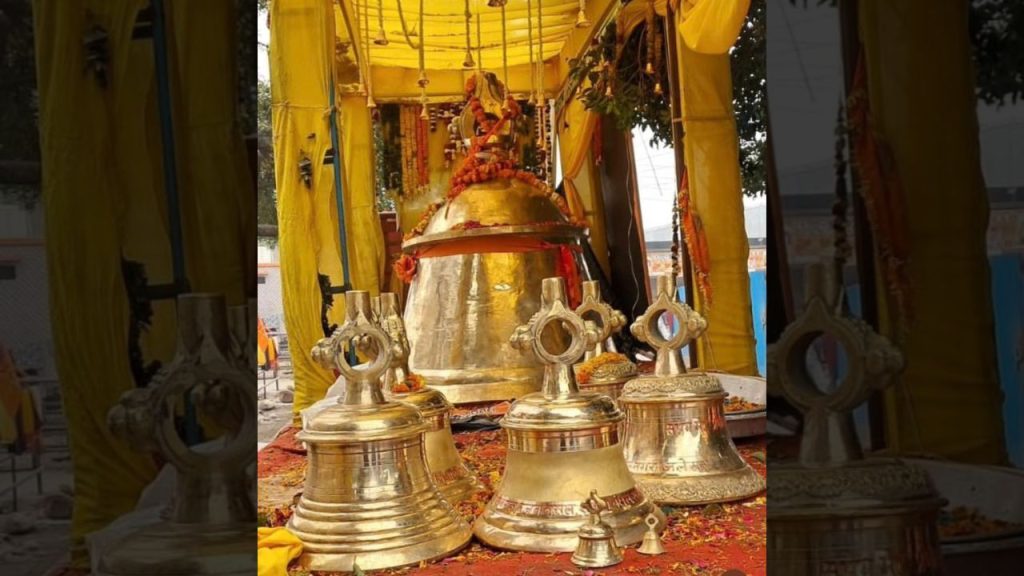In a remarkable display of craftsmanship and devotion, a monumental bell weighing 2,400 kg is set to grace the Ram temple in Ayodhya. Crafted from ‘ashtadhatu,’ a combination of eight metals, this extraordinary creation has captured the attention of enthusiasts across the nation. The bell, valued at ₹25 lakhs, embarked on its journey to Ayodhya on Tuesday, transported with great care via train after traversing various subdivisions of the Etah district.
A team of approximately 30 skilled workers, representing a diverse range of talents, collaborated to bring this exceptional bell to life. Comprising gold, silver, copper, zinc, lead, tin, iron, and mercury, the bell is a testament to the intricate craftsmanship and dedication of the artisans involved. It stands as one of the largest bells in the country, measuring an impressive six feet in height and five feet in width.
What makes this bell truly unique is its single-piece crafting, ensuring a resonant sound that can be heard within a two-kilometer radius. The meticulous process involved in its creation spanned shaping and measuring components, creating wooden templates for the mould, metal preparation, tuning, grinding, and fitting the clapper.
The origin of this extraordinary donation can be traced back to the late Vikas Mittal, the former chairman of Jalesar Nagar Panchayat, who tragically passed away in 2022 due to cardiac arrest. Aditya Mittal, a metal trader, revealed that his late brother harboured a wish to donate this bell. In a gesture of remembrance and fulfilment of his brother’s desire, Aditya and his brother Prashant Mittal decided to donate the bell to the Ram temple.
The Mittal brothers received the order for the bell from the Nirmohi Akhara, a significant litigant in the Ayodhya title dispute, immediately after the Supreme Court’s decision in November 2019. Aditya Mittal expressed, “We believe there is some divine reason that this work came to us. So, we decided to donate it to the temple,” according to AP7AM News.
Etah, renowned for its intricate craftsmanship, has carved out a niche for itself in the world of bell founding and casting. From the tiny ‘ghungroos’ adorning anklets to massive ‘ghantis’ that grace temples, the brasswork from Jalesar, a town of merely 60,000 people, is a testament to the region’s unique expertise.
2100 kg Asht Dhatu Ghanta from Jalesar, Etah reaches Ayodhya.
6 feet high, 5 feet wide bell for Shri Ram Mandir was made by local craftsmen in 40 months.
Jalesar is known as ‘Ghant Nagri’, almost all bells in temples across Bharat are made here. pic.twitter.com/33kkPL3m0i
— The Uttar Pradesh Index (@theupindex) January 11, 2024
The distinctiveness of Etah’s brassware lies not only in the craftsmanship of its artisans but also in the composition of its soil, believed to be especially well-suited for crafting moulds that enhance the acoustics and resonance of brass. Whether it’s the clay or the skilled hands of the artisans, the result is a range of pitch-perfect bells that can be found nowhere else in the country.Jalesar, despite its modest population, holds sway over India’s supply of ‘ghungroos,’ integral to various Indian dance forms. These bells are not just ornamental; they fulfil specific musical pitch requirements, a skill perfected by the local artisans of Etah.

While the district of Moradabad historically dominates India’s brassware industry, accounting for over 75% of the country’s brassware exports, Jalesar has successfully crafted a unique identity for its brass bells. Despite employing fewer than 200 workers compared to Moradabad’s 5,000, the town’s bell founding and casting industry have flourished, attracting attention for its singular products.
The industry, once on the brink of extinction, found a new lease on life through the state’s One District One Product (ODOP) initiative. Artisan training programs and financial support to factory units have resulted in the resurgence of this specialized skill, breathing fresh life into the district’s rich legacy.
However, the COVID-19-induced lockdown in 2020 dealt a blow to the industry’s recovery momentum. While Etah maintains a stronghold on the ‘ghungroo’ market, valued at over Rs 100 crore with significant growth before the lockdown, increased competition from four other districts shortlisted by the Union Ministry of Commerce & Industry poses a challenge. To retain its dominance, Etah must explore new markets for its bells. The prospect of UNESCO recognition and a geographical indication (GI) tag for bell-casting could further enhance the global appeal of Etah’s unique craftsmanship.

Yet, challenges persist. Issues like erratic electricity supply, occupational illnesses, and environmental concerns surrounding traditional coal-fired furnaces need addressing. The ODOP initiative, despite its success, must now focus on overcoming these challenges to ensure the sustainable growth and development of this specialised handicraft cluster.
The future of Etah’s bell-casting hub hangs in the balance, with discussions around potential relocation outside Jalesar and the Etah district itself. As these melodious bells echo not only in local temples but potentially in global markets, it is essential for the government and stakeholders to work hand in hand, preserving the legacy of this unique craft while addressing the hurdles that threaten its continued resonance.





